The Borbonicus is housed in what was formerly the Bourbon Palace and is today
the Bibliothèque de l'Assemblée nationale française in Paris.
It was painted on paper made from agave plants and probably was sent to Spain
during the 16th century.
Scholars believe that this codex was made in celebration of the New Fire Ceremony
in the year 2-Reed (equivalent to the year 1507), which is depicted on leaf 34
(item 17e). Topics represented include a record of the Aztec Sacred Year of 260
days with information for divination by the priests, the count of years in the
52-year cycle, and the count of the 18 veintenas and the ceremonies associated
with them.
The first 20 pages of the Borbonicus are a divinatory almanac containing a
full count of the 260 days in the sacred calendar cycle. Each page portrays a
trecena, the divine influences on the trecena, and the 13 days within
it. Predictions about persons born during each trecena could be read from
these pages; notations in Spanish were made to describe these natal influences.
The day names are translated in the surrounding smaller squares. Leaves 3-4, 10,
and 16 are from this count of days.
 |
- Borbonicus, leaf 10
Leaf 10 represents the tenth trecena, which begins with the day 1-Flint
(see glyph at the lower left of the page). This trecena is generally considered
to be of good omen. The Spanish-language text says "Los que aquí
nacían no podían ser aborrecidos," that is, "Those
born here cannot be hated." The two gods facing each other hold shared influence
over this trecena. They are Tonatiuh (god of the sun, at left),
and Mictlantecuhtli (lord of the land of the dead, at right). Between the
two gods, a man climbs a pole topped by the sacred eye, a feature of the festival
of Xocotl Uetzi. This may be representative of an opportunity to attain
distinction in the eyes of the competing forces influencing his life, or perhaps
it signifies a public test. The risk is of falling, of failing, of death. Other
images in the panel indicate key ceremonial elements to be performed, such as
images associated with bloodletting in autosacrifice, offerings of a heart, and
sacrificed birds. The combined images document the patterns of time, divine influence,
necessary rituals, and omens to predict the future.
|
|
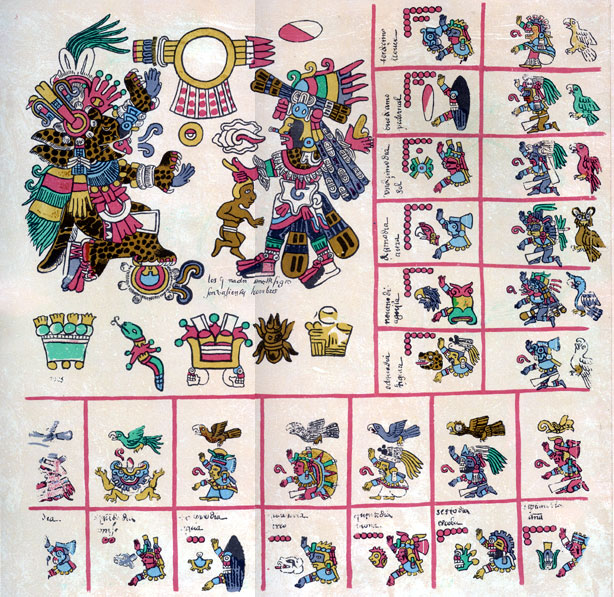
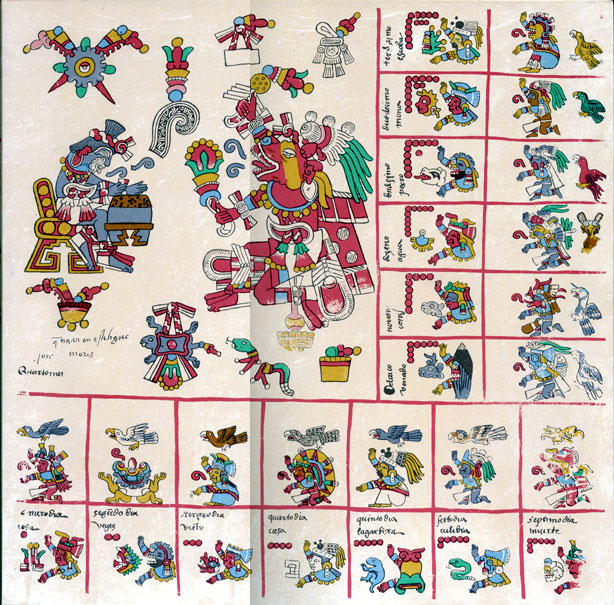
|
- Borbonicus, leaves 3-4
These are the first intact leaves of the Codex; leaves 1 and 2 were lost from
the original manuscript at some point in the past. Leaf 3 records the third trecena
of the Sacred Year. The small square at bottom left of leaf 3 shows that 1-Deer
is the first day of this trecena. The large inset depicts two gods of opposing
forces. At right is Quetzalcóatl, whose name derives from the words
Quetzal (bird) and Coatl (serpent); he therefore is often referred
to as the Feathered Serpent. He was the god of the wind, and the one who brought
the breath of life to humankind. He is associated with the Great Star (Venus),
primarily in its morning phase. He wears a pentagonal adornment made from a large
sea shell that symbolizes the cycle of his coming from the ocean, returning to
it, and possibly returning again in the future. He holds a child to represent
his association with fertility and life.
At the left is Tezcatlipoca, frequently called the Dark or Smoked Mirror.
He is represented by one or more obsidian mirrors which he carries, and which
are representative of his role as the god of darkness and deception. Tezcatlipoca
is the brother of Quetzalcóatl and is associated with the night
sky, and sometimes with the evening phase of Venus. He is dressed in a tiger skin,
one of the disguises that he typically assumes. The spots on the tiger skin evoke
the scatter of stars in the night sky.
Leaf 4 depicts the fourth trecena, which begins with the day 1-Flower
and is associated with the gods of music and dance. Huehuecóyotl
is the god of song and is shown singing, as represented by the spiral extending
from his mouth. He holds a bouquet in his left hand and a maraca in his right.
A second figure, dressed as Macuilxóchitl, or 5-Flower, plays the
foot drum. He is the god of flowers and games, and a patron of music and dance.
|
 |
- Borbonicus, leaf 16
Within the 20-page count of days in the Borbonicus, leaf 16 is unique in having
a colorful border. This broad border is symbolic of water and surrounds the entire
panel, with the exception of the midpoint of its upper edge, where it meets a
representation of the upper world or sky. The central image shows the gods Xolotl
(night ruler of Venus and twin brother of Quetzalcóatl) and Tlachitonátiuh
(one of the deities that the sun god, Tonatiuh, becomes as the sun makes
its daily journey from night to day). Tlachitonátiuh is in the process
of being captured and slain by the Evening Star. He is swallowed up to become
the deity Yaomicqui, who will travel through the earth accompanied by the
dead until the sun is reborn the next morning.
|
|
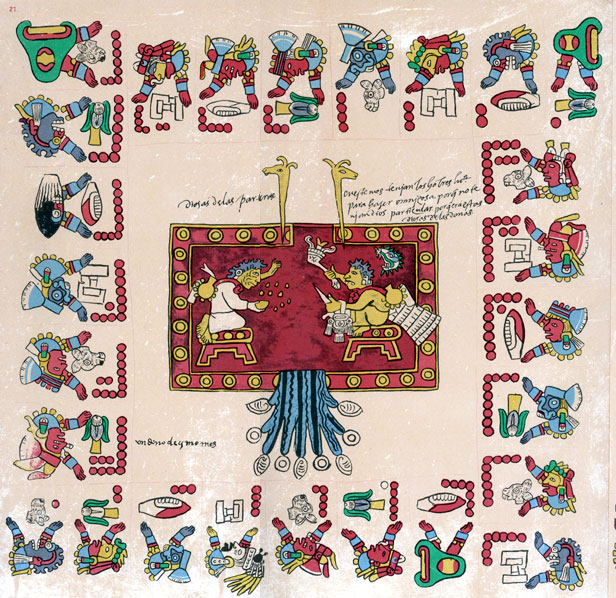
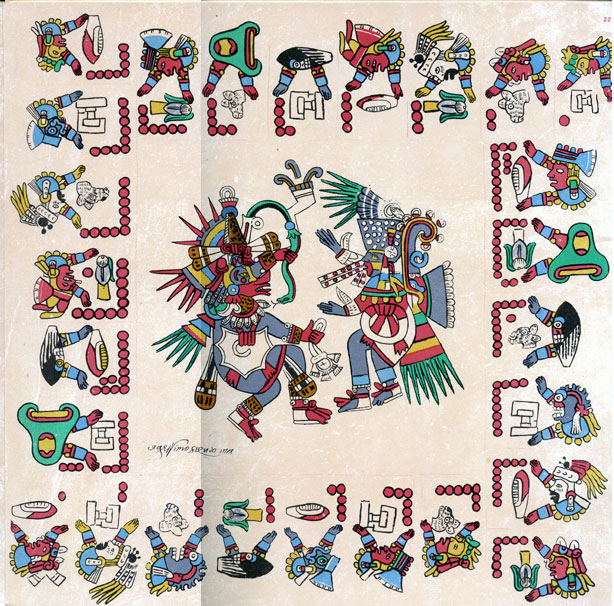
|
- Borbonicus, leaves 21-22
Leaves 21 and 22 document the count of years. The dates of the first days of
each of the 52 solar years are shown in order, together with their relation to
the nine lords of the night (deities associated with the movements of the celestial
bodies). This 52-year cycle can be explained by the interweaving of the sacred
and solar calendars. Mathematically, it is only possible for 4 of the 20 day signs
of the Sacred Year to fall on the first day of the Solar Year. These four sacred
day names are known as "year bearers," and each occurs in combination
with a number from 1 to 13 to fully name the day. This particular combination
would occur on the first day of the year only once in 52 years. The figures in
the center of each leaf represent the creation (leaf 21) and revision of the sacred
calendar (leaf 22). Quetzalcóatl, who plays a major role in the
story of the revision of the calendar to include veintenas, appears at
center left in leaf 22.
|
|
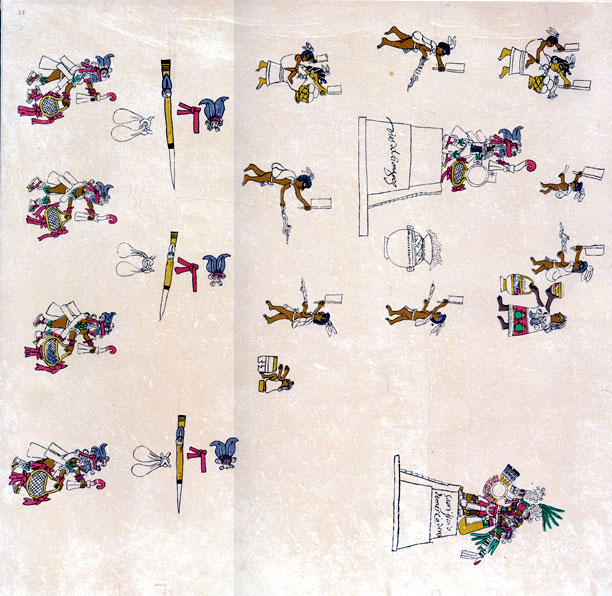
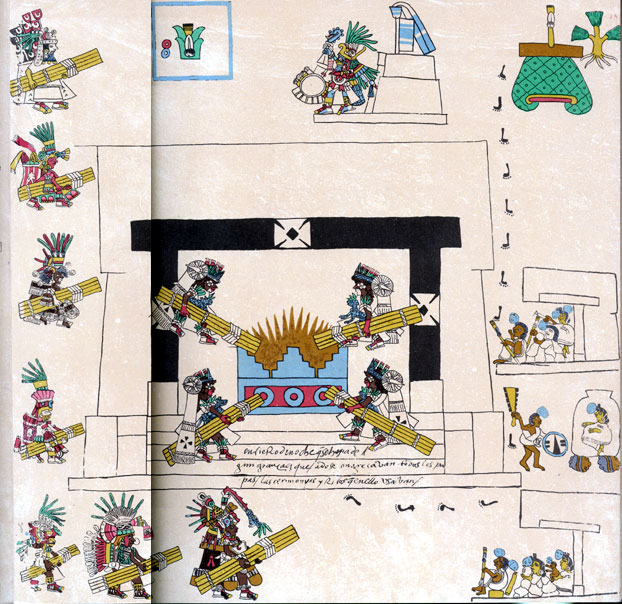
|
- Borbonicus, leaves 33-34
Leaves 33 and 34 are from a calendar depicting ceremonies to be performed during
the various veintenas, as well as those performed at the end of the 52-year cycle.
Leaf 33 depicts the ceremonies of the 14th veintena, which features
the god Mixcóatl. He stands atop his temple wearing a headpiece
of eagle feathers and a red belt. In one hand he holds a shield and a basket adorned
with red ribbons, in which he carries provisions for the hunt. Among the other
figures on the page are four hunters dressed as Mixcóatl, a group
of six dancers, two people presenting baskets of tamales, and an old woman bringing
additional offerings. The god Tezcatlipoca, shown on his temple below Mixcóatl,
awaits the human sacrifices that will end the ceremonies.
Leaf 34 shows the ceremony of the New Fire (Fuego Nuevo) at the end
of the 52-year cycle. This ceremony was of great significance. Fires were extinguished
and tools broken to represent the end of the old in preparation for renewal of
the essential flame. At the top of the page are the symbols for the year and month.
At bottom left is a procession of the gods, or perhaps priests dressed as gods,
preparing to renew the fire. Numerous sacrifices were performed to feed the gods
at this essential threshold in the calendric cycle.
|
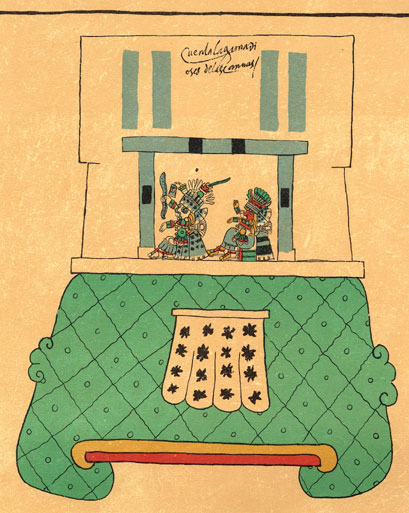 |
- Borbonicus, leaf 35
Leaf 35, one of the last pages of the Borbonicus, depicts Tlaloc on
his green mountain. He is the ancient and revered god of rain, and the one who
makes things grow. Tlaloc wears his characteristic mask reminiscent of
eyeglasses and a mustache. Blue is his dominant color. Behind him is Chalchiuhtlicue,
goddess of the seas and lakes, who is also associated with ceremonies performed
during the birthing process.
|



